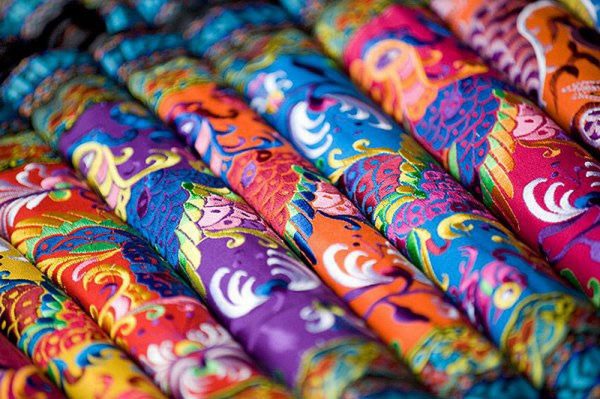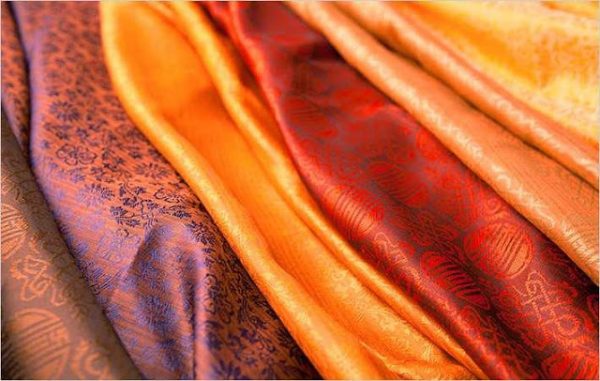Nội dung
World silk production: Renowned for its regal status, natural silk stands as the epitome of fine fibers with a rich historical legacy.
In ancient times, it was exclusively reserved for kings and royal families, symbolizing its premium allure. Boasting ethereal qualities, silk captures iridescent light, revealing a spectrum of vibrant hues.
Defined by its animal protein fiber composition, silk features a triangular prism-like structure that refracts light at diverse angles, producing a captivating metallic backdrop for this exquisite fabric.
Unveiling the top 6 countries of the world silk production, each contributing uniquely to the vibrant tapestry of the silk industry.
Leading Silk Producers: Unveiling the Top 6 Countries
China
The inception of silk fabric dates back to 3630 BC in China, where it was initially crafted and revered as a national treasure exclusively for the royal family. Over time, its influence permeated Chinese culture at large.
By 2005, China emerged as the unrivaled leader in global raw silk production, contributing a staggering 74% to the worldwide output and commanding a 90% share of the export market, totaling 290,003 tons. Subsequently, in 2009, production soared to an impressive 574,099 tons.
Even in 2018, China maintained its dominance, producing 146,000 tons, securing its position as the world’s foremost silk market. China’s historical significance in silk production is further underscored by the construction of the Silk Road, a trade route connecting Chang’an to African nations. This strategic endeavor aimed to bring Chinese silk to the global market, fostering connections with Central Asian countries, Europe, and Africa, while also safeguarding the closely guarded secrets of silk production.
India
In India, silk boasts a profound historical lineage, known as “Resham” in the eastern and northern regions, and “Pattu” in the southern part of the country. Archaeological findings at Harappa and Chanhu-daro indicate the existence of silk craftsmanship in South Asia during the Indus Valley civilization, spanning from 2450 BC to 2000 BC. Notably, China’s silk production traces back to 2570 BC.
Presently, India stands as the world’s second-largest silk producer, following China. A noteworthy 97% of raw silk originates from five key Indian states—Andhra Pradesh, Karnataka, Jammu and Kashmir, Tamil Nadu, and West Bengal – each contributing its unique style and design to the silk industry.
Moreover, India claims the title of the world’s largest consumer of silk. In 2009, the country produced an impressive 131,661 tons, a figure that held India’s rank as the second-largest silk producer globally in 2018, with an output of 28,708 tons, trailing only behind China.
Uzbekistan
Despite the contemporary automation of silk thread production and basic clothing manufacturing, the breeding of silkworms in Uzbekistan predominantly takes place on individual farms, a practice that has endured since the 4th century. In the traditional approach, most cocoons are bred on these farms.
In the late April to early May timeframe of past agricultural years, the Uzbekistan government distributed silkworm eggs, averaging 20 grams, to farmers interested in raising them. Silk fabric is a prevalent material in a wide array of clothing types within the country.
Uzbekistan boasts an annual cocoon production of approximately 30,000 tons. In 2009, the country recorded a silk production of 25,896 tons, and by 2018, this figure had reached an output of 1,100 tons.
Brazil
As the foremost silk producer in South America, Brazil achieved an impressive output of 4,835 tons in 2009, marking a development in the industry during more recent times. Brazil engages in the harvesting and exportation of both raw silk and silk yarn.
Distinguishing itself as the sole country outside of Asia where silk production continues to grow steadily, Brazil confronts challenges from competing industries. The silk season in Brazil unfolds from September to October, extending until May, with farmers cultivating the silkworms throughout the year. Notably, Brazil recorded an output of 560 tons in 2018, underscoring its ongoing contribution to the global silk market.
Thailand
Silk production is a year-round endeavor in Thailand, particularly flourishing after the rice harvest. The country utilizes two types of silkworms, the cultivated Bombycidae and the wild Saturniidae, to ensure a continuous silk supply. Various regions in Thailand boast distinct silk varieties, showcasing diverse colors and designs.
Traditionally entrusted to women, silk weaving in Thailand involves the use of handlooms and relies on skills passed down through generations. Although a time-intensive process – taking 40 hours to hand-spin half a kilogram of Thai silk – the end result is marked by exceptional quality.
Following hand spinning, the yarn undergoes bleaching to eliminate the natural yellow hue of Thai silk before being intricately woven on traditional hand looms. While modern silk production incorporates motorized reels, there remains a substantial demand for manually crafted silk threads. In 2009, Thailand contributed significantly to the global silk market with a production of 4,655 tons. Despite a decrease to 692 tons in 2018, Thailand remains a notable silk-producing country with substantial output in Southeast Asia.
Vietnam

Nhasilk – World Silk Producer, Vietnam
Ranking as the 3rd largest silk exporter in Asia and 6th globally, Vietnam showcased a robust output of 420,000 tons in 2018. Regardless of its standing within the top 3 or 6, Vietnam’s silk production capacity remains robust. The market exhibits openness and significant development potential, especially as Vietnamese silk weaving companies increasingly invest in scale, machinery, and advanced production techniques.
Notably, traditional craft villages, with a history spanning thousands of years, are actively engaged in restoration and redevelopment efforts. This commitment adds diversity to the market, offering products steeped in national traditions and acting as a wellspring of inspiration. Moreover, these initiatives serve as a spiritual impetus, propelling the development of Vietnamese silk into the global market with greater force.
Conclusion for world silk production
In conclusion, the global silk landscape is characterized by a rich tapestry of production, with each country contributing its unique thread to the intricate fabric of this ancient industry. From China’s historical Silk Road legacy to India’s consummate embrace of silk, and Brazil and Uzbekistan’s dynamic emergence as formidable producers, to the resilience and innovation displayed by Thailand and Vietnam, these nations collectively shape the diverse narrative of silk on the world stage. As they navigate modern challenges, invest in technology, and preserve age-old traditions, the future of silk production holds promise, with the potential for continued growth, creativity, and global influence.
The world silk producing nations, each with its distinct flair and contribution, continue to weave the fascinating story of silk that transcends time and borders.







